#the community i play with flags when someone has covid (sometimes...) but takes no preventive measures
Text
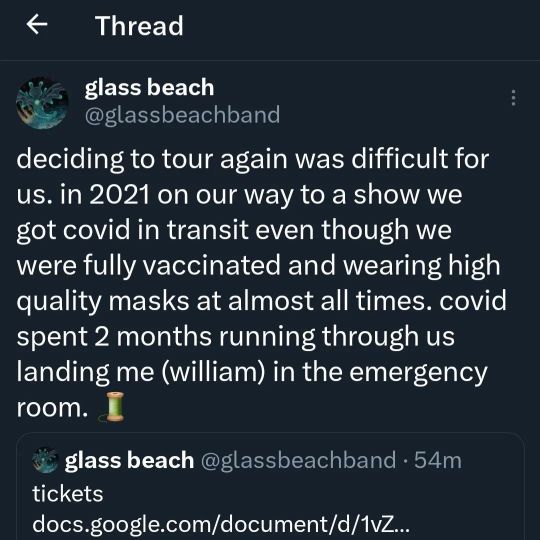


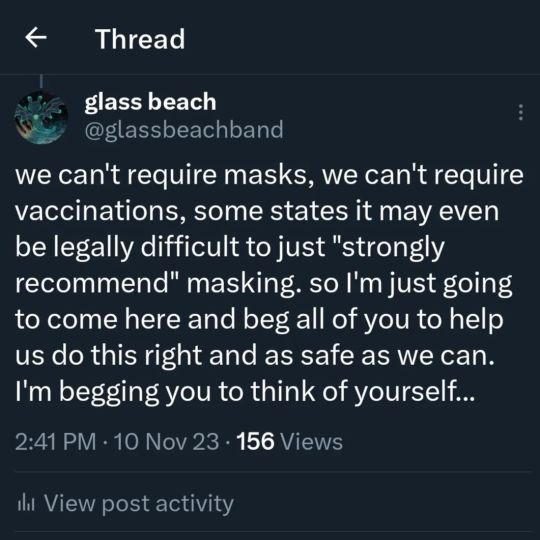
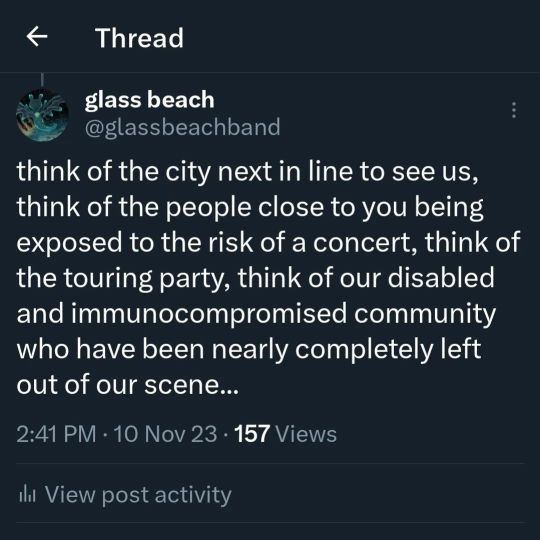
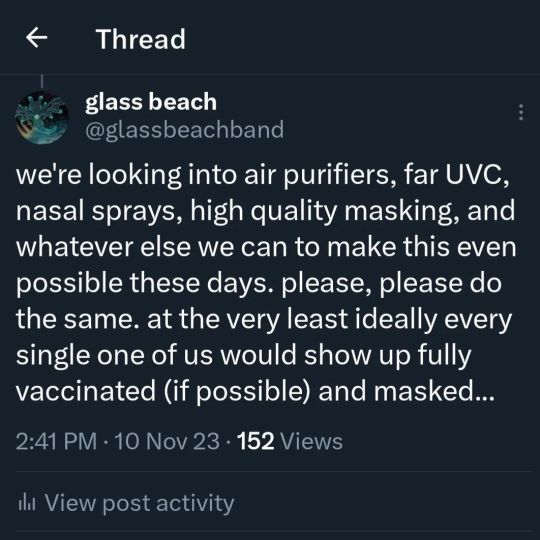
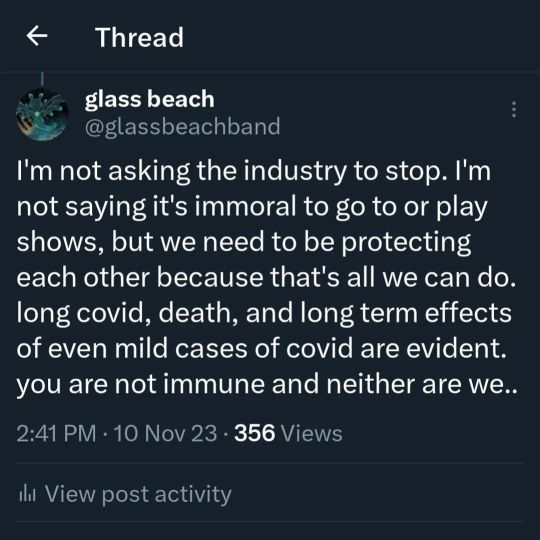
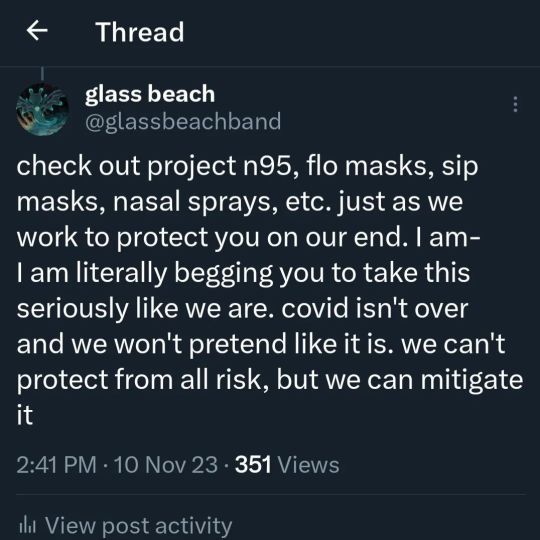
so I'm just going to come here and beg all of you to help us do this right and as safe as we can. I'm begging you to think of yourself...think of the city next in line to see us, think of the people close to you being exposed to the risk of a concert, think of the touring party, think of our disabled and immunocompromised community who have been nearly completely left out of our scene.
Glass Beach on touring during COVID (x)
#haven't been on here much this week/end but was surprised not to see anything about this#basically no one masks at shows i go to anymore...#the community i play with flags when someone has covid (sometimes...) but takes no preventive measures#i appreciate the band talking candidly not only abt how covid impacted tours during the height of the pandemic#but how it continues to impact folks today (covid is soo not over) and how touring parties are discouraged and dis-empowered from preventio#glass beach#🚲#glass beach band
1 note
·
View note
Text
Assignment 2
ID: 111485
Number of words: 1476
Course Name: Issues in Mass Communication
Course Code: MASS2620
Date: May 31, 2020
Introduction:
The current century is media century. It does not mean we started use the media in this century only, but the usage of the media accelerated much more nowadays. We are not able to identify when it was start. Media can do many, it can be an agent of transformation and social change, but this should connect with the combatting of disinformation and misinformation in order to have media and information literacy (MIL). Using media need awareness because it influences the audience and that cannot be achieved without understand the how the process of media influence works. Otherwise, media faced many challenges which may restrict its work. That can be from the audiences, from governments, and from many stockholders in many aspects. The importance of the media become clear in crisis situation by effective communication which known as key pillar of most crisis governance.
Submitted material:
1. Disinformation:
Wide spread of the media among public lead to reduce the ability of disinformation. They be able to distinguish true from fake news. It aims at influencing public opinion. They believe that spreading false news and fabricating shocking stories of public beliefs is more influential than advertising.
2. Cognitive strategies:
When an individual acquires a new cognitive strategy, this strategy can be applied to any treatment regardless of the content that this strategy addresses, and this applies to information provision strategies. There are individual differences in cognitive strategies between individuals, some strategies that some possess are better than others, and these differences are due to the level of learning and thinking. Cognitive strategies help to understand how media deals with social and political issue.
3. Communication used in Cold War, WW1, WW2, The American coalition invasion of Iraq.
Media started since long time ago for example, in WW1 there were many communication ways used like, Signal flags, telephone and two-way radio, ships. Which used to convey visual messages and signals between two ships or to shore. In WW2 they used Propaganda, Newspapers/Magazines, Radio, Airplanes, Telegraph, Telephones, Mail, Animals, and Cryptology. While in cold war They establish the central Intelligence Agency *CIA*, which lead to act a new radio service a a project for public diplomacy. In American Coalition Invasion of Iraq, United States of America launched a major propaganda attack on Iraq, including films and fake news.
4. How do media outside Oman present race, gender (Male, Female & 3rds)
The race has always been the primary media for judging individuals and their behaviors. If we look to gender, there are male and female and this is the known partition, but the media continues to present the third well and considers them to be minorities. In Oman, media did not show anything related to the third gender. and they do not talk about it despite its existence in secret. Because of some laws.
5. Selfie and narcissism - fame online
The fame online has a relation with selfie and narcissism. Most artists have technical interest and They prefer work that allows for self-expression. Artist can influence society and trends that is way they change their behavior depending on the community and his opinion Happiness hormone is what drives the average person to take a selfie. On the other hand, artists only show the positive side of their life that is way people thinks their life are perfect.
6. Hate speech
Hate speech can be verbal or written communication which reflects a negative opinion about a particular demographic, it often targets particular races, genders, sexual orientations, nationalities, ethnic groups and religions. It can be identified if there is an attack to someone for these immutable. Social media is a good media to exacerbate this problem like what people shoed on twitter against china because of covid19.
7. The role of media in health education
Media can play a critical role in educate people because it can reach wide numbers. In health aspect, it uses to inform the public about certain disease like what happened with covid-19. It is an excellent way to Raise people's awareness, transfer information, and change behavior. It also can use to educate people about disease prevention.
8. Cartoon about covid-19
Cartoon is one of the good ways to discuss an issue. During Coronavirus there are many cartoons and it divers between fun cartoon, educated, or help understanding the issue. Most of the people especially in social media are react with this in different views because it is better than words.
9. The citizens have the right to know everything through media.
Not everything has to know by the citizens through the media nor everything has to hide. Some issues were hidden and that led to some truble problems and showing some of them led to other problems. It will be in a safe side if the media show what will benefit the citizen only and hide anything which may exacerbates the issue.
10. perspective about media ethic challenges
Media ethics faced many challenges for example; Truth and the public interest, privacy, integrity and impartiality, and accuracy with reliability. During coronavirus media faced these ethic challenges. The informative were forced to breach people's privacy and they not be able to be accurate in most news. they also hide some truth, and this is against public interest. Integrity and impartiality also became a challenge too.
Analysis:
Why media sometime refuge to show disinformation? Is this one technique to attract more people?
In general, most people nowadays are becoming more clearly understand of most currently issues. The wide spread of media led to give the audience many views for one issue and that help them to see the issue from many sides. This is very differed from media that shown in WW1, WW2, Cold war, and The American coalition invasion of Iraq. Critically evaluate of the point that talk about cognitive strategy, this strategy is not a common property among individuals, but it shows the difference between people in their ability to understand certain issue in mass media. For example; the issues that focus on the difference between the individuals and divide them according their race, gender, color, and many other portions. In Oman the media are not allowed to show these divisions even if some people are thought about it. By compare, if we retain back to what happened in united states on May,2020 when a white policeman assaulted a black citizen and kill him, but he was acquitted. This is racism in America. Why media should show this issue? Is this will change the reality in America? Or it will aggravate the racism issue? These is all control by mass media. More specifically on how media affect our life, is what we faced nowadays because coronavirus. Health aspect are adapted too much to media to be with citizens. it advises them, punish them, and help them how to prevent from this pandemic. Coronavirus show the real and positive side of media. It used by many people even if they had no relation with media, coronavirus forced them to use it because media became the supper importance thing. They use cartons also because some people do not like to read but carton can tell them more that one thousand words. Critique to one issue that show in social media about selfie and narcissism, I see that is something excessive and many people want to be an artist regardless if they have a message to the audience or not. People start to follow the artist's life and most of the teenager thought the life is pink all of the time because these artists are show only the positive side of their live. Media always faced many challenges but is this should be an excuse to have a weakness in mass media? everyone goes to media medium, have to put in mind that whole life will be as a challenge. Little mistake may affect many people life and it can may cause a chaos in mediums. Comment on hate speech issue, media can some time manage this. For example, twitter can hide any tweet that has a hate speech and people can make a report and spam to any account that show a hate speech activity.
Conclusion:
Overall, media is a double-edged sword. We have to be carful when use it and also, we need to be aware when get any information from it. No one have the right to force other to accept his opinion about some issue. We all can decide which issue I am interest in, and which is not. Disinformation, cognitive strategy, selfie and narcissism, hate speech, and many other issues are issue in media communication.
2 notes
·
View notes
Text
Why Immunity to the Novel Coronavirus Is So Complicated
https://sciencespies.com/nature/why-immunity-to-the-novel-coronavirus-is-so-complicated/
Why Immunity to the Novel Coronavirus Is So Complicated

Even before the blood left his arm, André Valleteau suspected he knew what his doctors would find.
Just weeks before, the 27-year-old from Toronto had tested positive for SARS-CoV-2, the coronavirus that causes COVID-19. The symptoms hit him hard: headache, cough, sore throat and fatigue that relegated him to his bed 15 hours a day. “It didn’t matter how many times I napped,” he says. “I was tired until the next time I napped again.”
Valleteau, a researcher coordinator at a pharmaceutical company, spent two weeks self-isolating and recovering, then decided he wanted to help others do the same. He contacted a local researcher and offered up his blood—along with the disease-fighting antibodies that likely teemed within. Indeed, Valleteau’s blood tested positive for antibodies against SARS-CoV-2, and a team of scientists is now studying molecules from patients like Valleteau in the hopes they can inform the development of drugs or vaccines to vanquish the virus.
Antibodies, which the body makes in response to dangerous microbes like SARS-CoV-2, are crucial for defending against disease. Many can glom onto pathogens and subdue them before they have a chance to encounter vulnerable human cells. Antibodies are also evidence: Some COVID-19 tests target these molecules because they show that someone has previously been infected with SARS-CoV-2. (And as previously reported, the possibility of false negatives or false positives, which are more common with some tests than others, can sometimes muddle attempts to pinpoint past infections.)
Even then, while a positive antibody test (also called a serology test) can say a lot about the past, it may not indicate much about a person’s future. Researchers still don’t know if antibodies that recognize SARS-CoV-2 prevent people from catching the virus a second time—or, if they do, how long that protection might last.
Immunity isn’t binary, but a continuum—and having an immune response, like those that can be measured by antibody tests, doesn’t make a person impervious to disease. “There’s this impression that ‘immunity’ means you’re 100 percent protected, that you’ll never be infected again,” says Rachel Graham, an virologist studying coronaviruses at the University of North Carolina’s Gillings School of Global Public Health. “But having immunity just means your immune system is responding to something”—not how well it’s poised to guard you from subsequent harm.
It takes a symphony of cells
In discussions of immunity, antibodies often end up hogging the spotlight—but they’re not the only weapons the body wields against invaders. The sheer multitude of molecules at work helps explain why “immunity” is such a slippery concept.
When a pathogen infiltrates the body, the immune system mounts a defense in two acts. First comes the innate immune response, a blunt, broad-acting ensemble that attacks any invader that doesn’t resemble a normal-looking human cell. Slower but more specific is the adaptive immune response, a second wave of assailants the body custom-builds to recognize unique features of the infectious microbe.
This second wave includes antibodies, which are manufactured by immune cells called B cells. Some antibodies are potent weapons that curb a microbe’s capacity to latch onto and enter cells, while others simply flag germs or infected cells for destruction by other parts of the immune system. The former category, called neutralizing antibodies, are necessary to combat most of the pathogens that plague humans, and their production is generally considered a hallmark of a good vaccine, says Sallie Permar, a virologist and vaccine expert at Duke University says.

A laboratory technician holds a bag with samples ready for COVID-19 testing, including blood for an antibody test, at SOMOS Community Care site in Washington Heights Latino community.
(Lev Radin/Pacific Press/LightRocket / Getty Images)
Although antibodies have a short lifespan, disappearing from the blood after a few weeks or months, the immune system retains some of the B cells that produce them. If the same germ returns, these cellular factories will whip up a big batch of antibodies to wage a second war. But antibodies alone aren’t enough to quash an infection, says Diane Griffin, an immunologist at Johns Hopkins University’s Bloomberg School of Public Health. “You need an orchestra of responses [for protection] to really be effective.”
T cells—another subset of the adaptive response—are often left out of conversations about immunity.
“You can’t have a great antibody response without T cells,” says Akiko Iwasaki, a virologist and immunologist at Yale University. Among a slew of helpful functions, T cells help young B cells mature into antibody-making machines. “These things really go hand in hand.”
T cells are also formidable fighters in their own right. In a bid to stop the spread of a pathogen throughout the body, some T cells will trigger infected cells to self-destruct. Others linger after an illness has resolved, patrolling tissues so germs can’t reestablish a foothold. (One of the reasons that HIV is such a devastating diagnosis is that the virus destroys some of the body’s T cells.)
Studies of other coronaviruses, including the ones that cause SARS and MERS, show that T cells play integral roles in stamping out sickness, says Stephanie Langel, a virologist and immunologist at Duke University. It’s likely that the same will hold true for SARS-CoV-2. Compared to antibodies, however, T cells—which often hole up in hard-to-reach tissues like the lungs—are more difficult to extract and analyze. That makes T-cell detection unlikely to play much of a role in clinical tests for immune responses against SARS-CoV-2. For researchers, though, T cells “represent a wealth of knowledge” about how our immune systems deal with the new coronavirus, Langel says.
Antibodies aren’t perfect
Even the most sensitive laboratory tests have their limits, and finding antibodies against SARS-CoV-2 is no guarantee that those molecules are high-quality defenders or that a person is protected from reinfection.
Most commercially available antibody tests search a person’s blood for antibodies that can recognize SARS-CoV-2’s spike protein, the molecule the virus uses to attach to human cells. Some (but not all) of these assessments can tell how many antibodies a person is producing—the more the better, generally speaking. But typical tests don’t determine whether the antibodies are neutralizing. To come to that conclusion, researchers must mix antibodies with viruses and check whether they stop the pathogens from invading human cells in a laboratory under strict safety protocols.

A T cell (blue) engages its target cell for destruction.
(Alex Ritter, Jennifer Lippincott Schwartz and Gillian Griffiths, National Institutes of Health / flickr)
Though non-neutralizing antibodies can play less direct roles in incapacitating a pathogen, many are duds that have no effect on microbes. Some may even chauffeur active viruses into healthy cells, inadvertently accelerating infection. “Essentially, the antibody helps the virus replicate,” Permar says. This rare phenomenon, called antibody-dependent enhancement, has been observed with the viruses that cause dengue and Zika.
Why antibodies can be so inconsistent is still a mystery, in part because laboratory experiments can’t recreate the conditions these molecules experience in the body, says Marcia Goldberg, a microbiologist at Harvard University. “It’s really important to actually test how well antibodies are working in people.” (One way to do so involves administering antibodies to patients battling COVID-19, something that’s being trialed in hospitals around the world.)
Even antibodies with known neutralizing powers aren’t foolproof. Donna Farber, an immunologist at Columbia University who studies T-cell responses against airway viruses, says that some patients with high levels of neutralizing antibodies in their blood still succumb to COVID-19, another hint that other parts of the immune system are needed to reliably defeat this disease.
That’s why antibody tests shouldn’t be overinterpreted, Iwasaki says. One common misconception is that a positive antibody test means a person no longer has the virus in their system, which isn’t necessarily the case. Antibodies are often roused about a week into a new infection, potentially overlapping with a pathogen’s tenure in the body. Diagnostic tests that search for the virus’ genetic material can help tease that timeline apart, but even these assessments can yield incorrect results.
“So much nuance is being lost by just saying ‘serology [antibody] positive’ and ‘serology [antibody] negative,’” Iwasaki says.
A range of responses
A person who has recovered from their first brush with a new pathogen like SARS-CoV-2 may travel one of several immunological routes, Goldberg says—not all of which end in complete protection from another infection.
One possibility is that the immune system does a great job of cataloguing the invader’s unique features. That intel will get stored in an army of B and T cells that will rally to fight the second time a germ comes around. B cells in particular play a starring role in this scenario, pumping out neutralizing antibodies that can sequester and disable a pathogen before it even has the chance to enter a host cell, Iwasaki says. This phenomenon, called sterilizing immunity, make people essentially resistant to reinfection. The body may rouse this reaction in response to microbes like the virus that causes measles, which tends to be a one-and-done infection for most people.

A scanning electron microscope image of SARS-CoV-2, the coronavirus that causes COVID-19.
(NIAID / flickr)
But not all pathogens prompt such a robust response—and not everyone reacts the same way to a given microbe. People can experience varying shades of partial protection in the wake of an infection, Goldberg says. In some cases, a bug might infect a person a second time but struggle to replicate in the body, causing only mild symptoms (or none at all) before it’s purged once more. The person may never notice the germ’s return. Still, even a temporary rendezvous between human and microbe can create a conduit for transmission, allowing the pathogen to hop into another susceptible individual.
Under rarer circumstances, patients may experience symptoms that are similar to, or perhaps even more severe, than the first time their body encountered the pathogen.
That doesn’t mean people are doomed to experience the same diseases over and over. “The word ‘immune’ makes it sound like the virus gets close to your body, hits a wall, and has to turn away and go find someone else,” says Allison Roder, a virologist at New York University. But even partial protection from the immune system will curtail the amount of pathogen in a person’s body, and, by extension, the likelihood of transmission.
None of these protective states are necessarily permanent or mutually exclusive. A person’s immunity to a pathogen can wane over the course of months or years, eventually dropping below a threshold that leaves them susceptible to disease once again. Researchers don’t yet know whether that will be the case for SARS-CoV-2. The widespread deployment of accurate antibody tests, which can track both where the virus has been and how people are faring after having it, may help answer that question. Scientists are also trying to determine the antibody levels that correlate with protection against reinfection and how durable those responses are over time.
Finding those answers will be a boon for vaccine development, Permar says. “The dream of every vaccine is to be able to say, ‘We need this level of antibody.’ Then vaccines can chase that endpoint. Until we know that benchmark… we’re operating in the dark.”
So far, early studies in both humans and animals suggest exposure to SARS-CoV-2 marshals a strong immune response. But until researchers have more clarity, Graham advises continued vigilance—even for those who have gotten positive results from antibody tests, or have other reason to believe they were infected with COVID-19.
Valleteau, who has received clinical confirmation the coronavirus is no longer in his system, is still practicing physical distancing, frequently washing his hands and wearing protective gear like face coverings. He’s also taking extra precautions around the patients he works with, many of whom have diabetes, a condition that can increase the risk of complications from COVID-19.
“This is not a free pass to act like nothing is going on,” he says. “Just because you’ve had it and recovered, you’re not absolved of social responsibility.”
#Nature
#05-2020 Science News#2020 Science News#Earth Environment#earth science#Environment and Nature#Nature Science#News Science Spies#Our Nature#outrageous acts of science#planetary science#Science#Science Channel#science documentary#Science News#Science Spies#Science Spies News#Space Physics & Nature#Space Science#Nature
1 note
·
View note